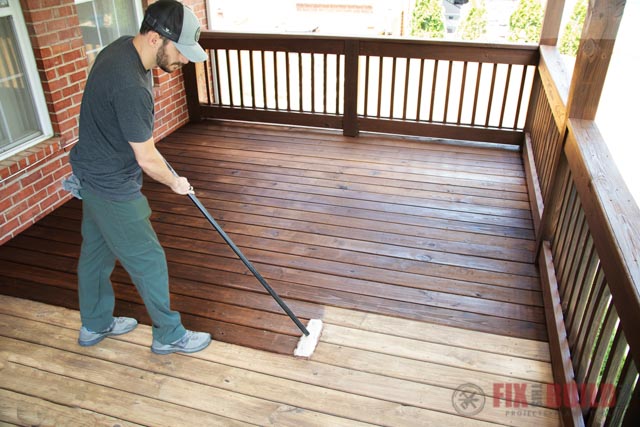Deck Staining Quality: Nourishing Your Outside Retreat
Wiki Article
Picking the Right Stain for Your Fencing: Tips and Factors To Consider
When it concerns enhancing the look and keeping of your fencing, picking the appropriate discolor is critical. With a wide range of choices available, it can be frustrating to determine which tarnish will certainly best match your needs. This guide will certainly provide you with considerations and pointers to assist you make an educated choice. We will explore the different types of fencing stains, elements to take into consideration prior to picking a discolor, pointers for preparing your fencing for discoloration, and the differences in between oil-based and water-based stains. Additionally, we will look into choosing the right tarnish shade to match your fence and improve your outdoor space. By following these guidelines, you can make sure that your fencing continues to be secured and cosmetically pleasing for many years to find.Comprehending Various Sorts Of Fencing Discolorations

On the various other hand, water-based spots are made from acrylic or latex and offer a much more subtle color to the timber. Water-based stains are much easier to cleanse up and have a much faster drying time compared to oil-based spots.
Picking in between water-based and oil-based discolorations depends upon different aspects, consisting of personal choice, the wanted look, and the degree of maintenance required. Oil-based stains are recommended for fences in high-traffic areas or those regularly subjected to severe weather. fence staining. Water-based discolorations, on the various other hand, are a preferred choice for fence suburbs where appearance and simplicity of use are important
When choosing the right stain for their fence,Recognizing the differences between water-based and oil-based spots helps homeowners make an educated choice. Thinking about the particular needs of the fencing, such as its location, direct exposure to sunlight, and preferred aesthetic, will certainly make sure that the chosen discolor offers lasting defense and improves the total appeal of the fence.
Elements to Consider Prior To Choosing a Discoloration

Different kinds of wood soak up stains in different ways, resulting in varying degrees of color strength and longevity. Additionally, specific timbers may be a lot more prone to concerns like rot or insect invasion, which might affect the option of tarnish to maintain the fence and shield.
The environment and weather condition problems in your area must additionally be taken right into account. You may require a stain that offers extra protection against moisture and UV rays if you live in an area with harsh winters or high moisture. Furthermore, if your fencing is revealed to route sunshine for extended periods, a tarnish with UV preventions can aid stop fading and staining.
Lastly, it is very important to consider your wanted visual. Different stains offer numerous shades and surfaces, allowing you to tailor the look of your fencing (deck staining). Take into consideration the general design and layout of your residential or commercial property, along with any kind of regional regulations or homeowner organization guidelines that might dictate check out here the acceptable tarnish colors
Tips for Readying Your Fence for Staining
Cleansing the fence is a crucial step as it eliminates dust, crud, and any kind of previous finishes that may interfere with the discoloration procedure. Scrub the surface carefully, paying added attention to locations with persistent stains or mold.After cleaning, permit the fence to dry totally. deck staining. This step is vital as staining a wet or wet surface area can lead to bad bond and an uneven coating. Depending on the weather condition conditions, it might take anywhere from a couple of hours to a couple of days for the fence to dry completely. Make sure that the fencing is entirely dry prior to waging the staining process.
Before discoloration, examine the fencing for any problems, such as loosened boards or nails. This product aids to open up the timber pores, enabling the stain to penetrate extra effectively and uniformly.

Contrasting Water-Based and oil-based Stains
When picking a stain for your fence, it is essential to compare the qualities and advantages of water-based and oil-based stains. Both types of spots have their very own benefits and considerations, so it is important to recognize the differences between them.Oil-based discolorations are recognized for their sturdiness and resistance to put on and tear. They permeate deeply right into the timber, providing outstanding security versus the aspects. They additionally boost the all-natural beauty of the wood by highlighting its grain and appearance. In addition, oil-based spots tend to last longer than water-based stains, making them a popular choice for fences.
On the other hand, water-based discolorations are a lot more environmentally pleasant and less complicated to clean up. They might not supply the same degree of security as oil-based stains, specifically in severe weather problems.
Eventually, the selection between oil-based and water-based discolorations depends upon your certain requirements and preferences. Take into consideration elements such as resilience, ecological effect, and simplicity of application when making your decision. Consulting with a specialist or seeking suggestions from experts can likewise aid guarantee that you select the right tarnish for your fence.
Selecting the Right Discoloration Color for Your Fencing
The option of a proper tarnish color for your fence is an essential aspect of improving its aesthetic allure and complementing the general layout of your outdoor area (deck staining companies near me). The right stain color can transform a level, regular fencing into a striking focal factor that adds deepness and character to your propertyWhen selecting a stain color for your fencing, it is very important to consider the design and architecture of your home. Natural tones such as neutrals and browns can create a cozy and welcoming look if you have a standard or traditional design home. On the various other hand, if you have a modern or contemporary home, you might consider going with vibrant and vibrant colors that make a declaration.
An additional factor to think about is the all-natural environments of your residential property. If you have a lot of greenery, a stain color that matches the all-natural landscape, such as environment-friendlies or deep reds, can create a cohesive and harmonious look.
Furthermore, it deserves taking into consideration the upkeep required for various tarnish shades. Lighter shades tend to show dirt and wear more easily, while darker colors can hide imperfections and require less frequent touch-ups.
Ultimately, the choice of tarnish color for your fencing should reflect your individual design and choices - fence staining. Make the effort to speak with and check out various alternatives with experts if required, to ensure that you pick the perfect stain shade that improves the elegance and allure of your fence
Conclusion
In final thought, when it involves picking the best discolor for your fence, it is essential to recognize the various kinds of stains available and consider aspects such as durability and desired appearance. Preparing the fence properly before staining is crucial for achieving optimal results. Additionally, contrasting water-based and oil-based discolorations can aid establish the most effective choice for your certain requirements. Finally, choosing the best stain color can boost the overall appearances of your fencing.We will discover the various kinds of fence stains, variables to think about before selecting a stain, pointers for preparing your fence for staining, and the distinctions in between water-based and oil-based stains.Differentiating in between oil-based and water-based spots is essential when understanding various types of fencing discolorations. Water-based spots are easier to clean up and have a much faster drying time contrasted to oil-based stains. Furthermore, oil-based stains have a tendency to last longer than water-based discolorations, making them a prominent selection for fences.
In verdict, when it comes to selecting the right discolor for your fencing, it is important to comprehend the various types of spots readily available and think about aspects such as resilience and preferred look.
Report this wiki page